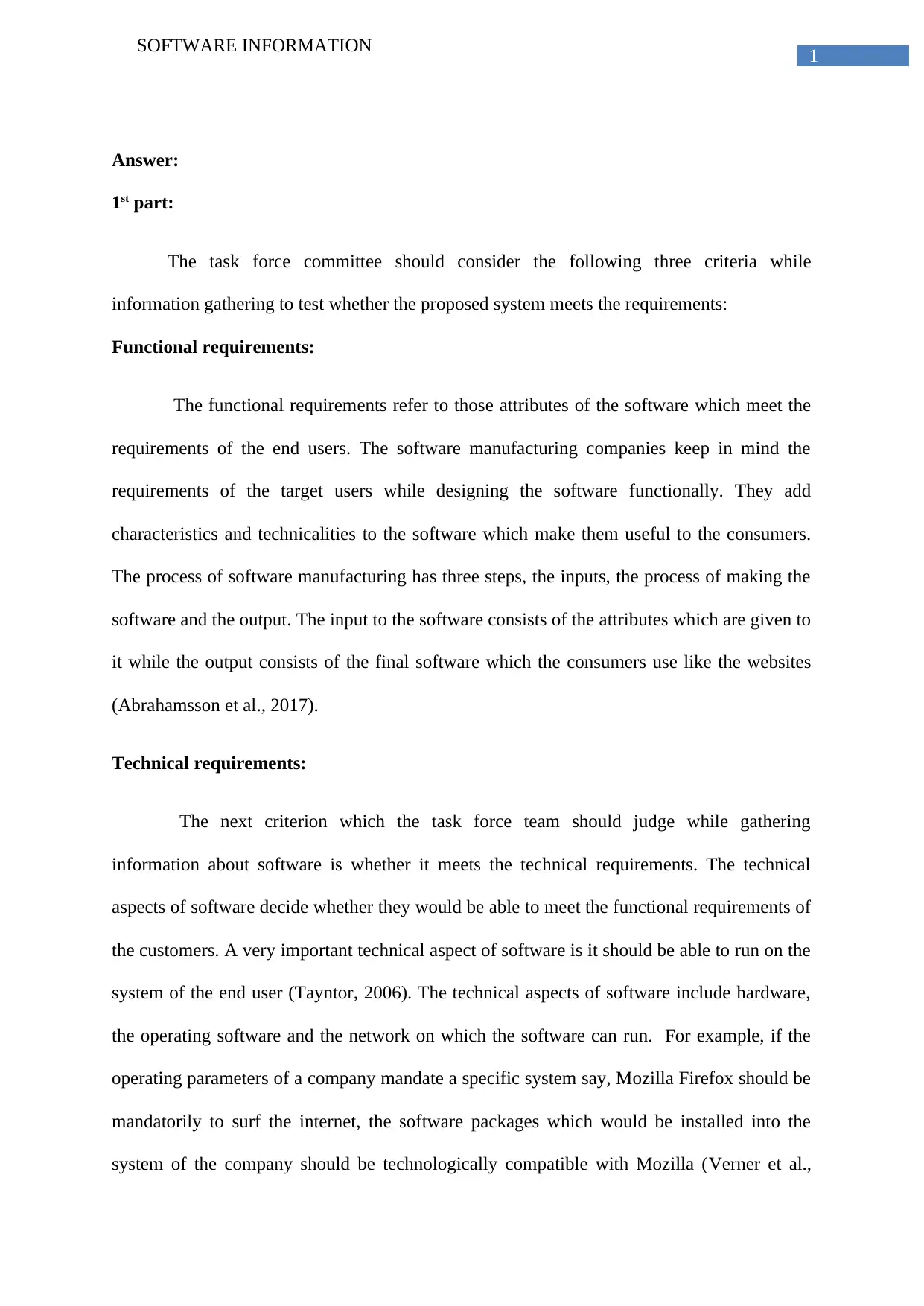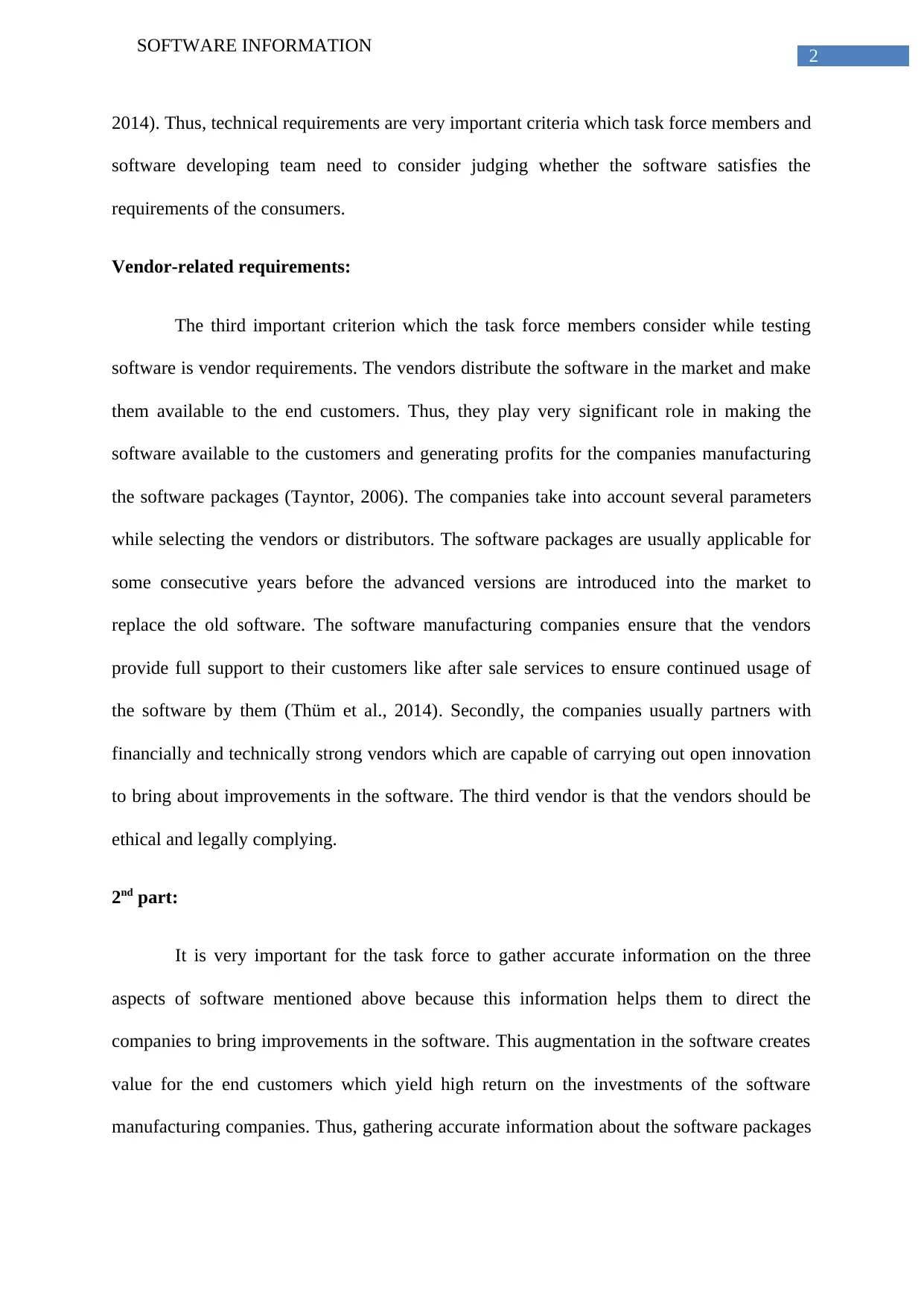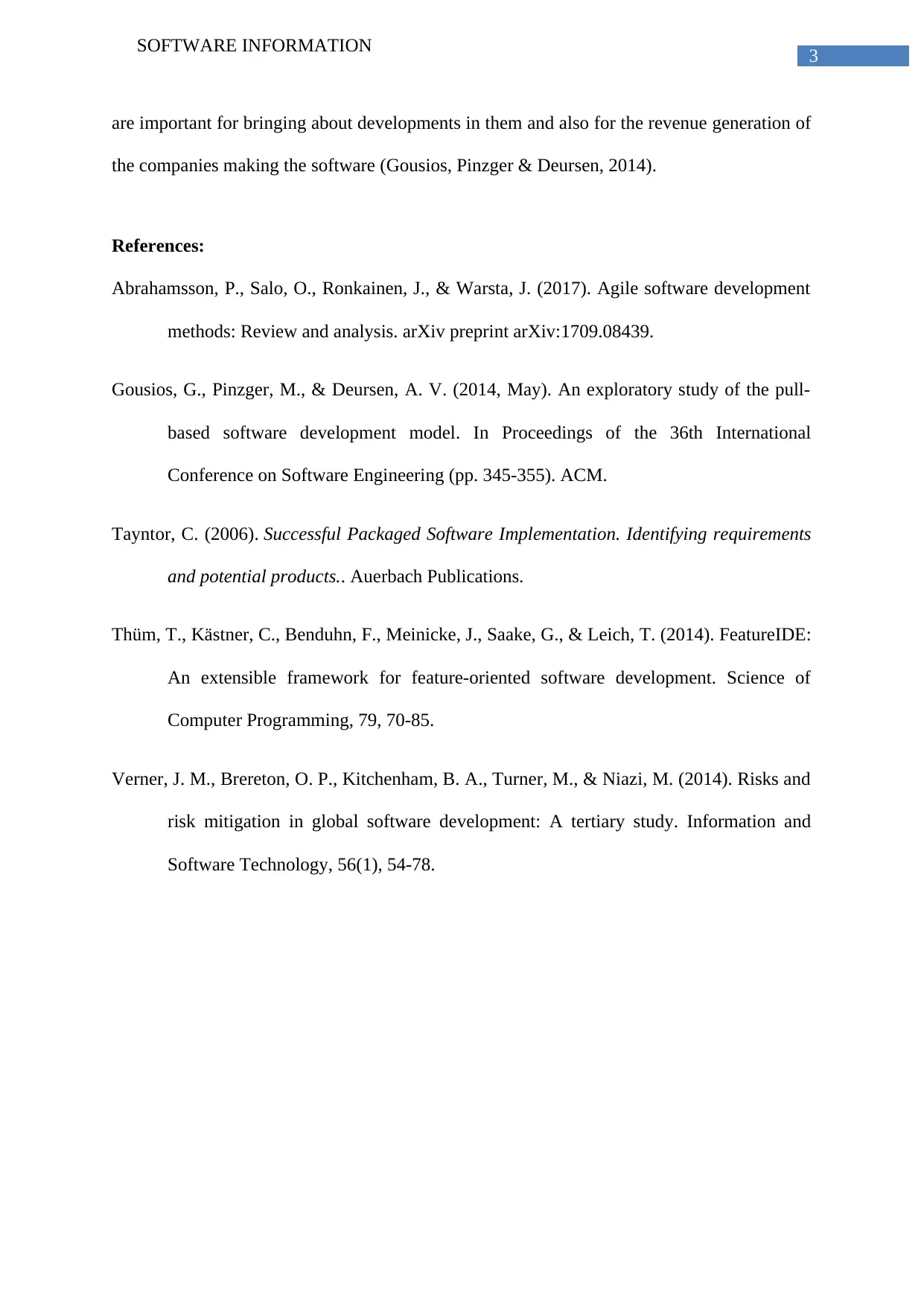Software Information: Evaluating Software with Task Force Criteria
VerifiedAdded on 2020/05/16
|4
|834
|63
Report
AI Summary
This report examines the essential criteria a task force should consider when evaluating software. It emphasizes three key areas: functional requirements, which ensure the software meets end-user needs; technical requirements, which guarantee compatibility with existing systems; and vendor-related requirements, which address vendor support and ethical practices. The report highlights the importance of gathering accurate information on these aspects to guide software improvements and maximize returns on investment for software manufacturing companies. By focusing on these criteria, task forces can effectively assess software packages, ensuring they meet consumer needs and contribute to company revenue generation. The report includes references to support the analysis.

Running head: SOFTWARE INFORMATION
Development of Software
Name of the Student:
Name of the University:
Author Note:
Development of Software
Name of the Student:
Name of the University:
Author Note:
Paraphrase This Document
Need a fresh take? Get an instant paraphrase of this document with our AI Paraphraser

1
SOFTWARE INFORMATION
Answer:
1st part:
The task force committee should consider the following three criteria while
information gathering to test whether the proposed system meets the requirements:
Functional requirements:
The functional requirements refer to those attributes of the software which meet the
requirements of the end users. The software manufacturing companies keep in mind the
requirements of the target users while designing the software functionally. They add
characteristics and technicalities to the software which make them useful to the consumers.
The process of software manufacturing has three steps, the inputs, the process of making the
software and the output. The input to the software consists of the attributes which are given to
it while the output consists of the final software which the consumers use like the websites
(Abrahamsson et al., 2017).
Technical requirements:
The next criterion which the task force team should judge while gathering
information about software is whether it meets the technical requirements. The technical
aspects of software decide whether they would be able to meet the functional requirements of
the customers. A very important technical aspect of software is it should be able to run on the
system of the end user (Tayntor, 2006). The technical aspects of software include hardware,
the operating software and the network on which the software can run. For example, if the
operating parameters of a company mandate a specific system say, Mozilla Firefox should be
mandatorily to surf the internet, the software packages which would be installed into the
system of the company should be technologically compatible with Mozilla (Verner et al.,
SOFTWARE INFORMATION
Answer:
1st part:
The task force committee should consider the following three criteria while
information gathering to test whether the proposed system meets the requirements:
Functional requirements:
The functional requirements refer to those attributes of the software which meet the
requirements of the end users. The software manufacturing companies keep in mind the
requirements of the target users while designing the software functionally. They add
characteristics and technicalities to the software which make them useful to the consumers.
The process of software manufacturing has three steps, the inputs, the process of making the
software and the output. The input to the software consists of the attributes which are given to
it while the output consists of the final software which the consumers use like the websites
(Abrahamsson et al., 2017).
Technical requirements:
The next criterion which the task force team should judge while gathering
information about software is whether it meets the technical requirements. The technical
aspects of software decide whether they would be able to meet the functional requirements of
the customers. A very important technical aspect of software is it should be able to run on the
system of the end user (Tayntor, 2006). The technical aspects of software include hardware,
the operating software and the network on which the software can run. For example, if the
operating parameters of a company mandate a specific system say, Mozilla Firefox should be
mandatorily to surf the internet, the software packages which would be installed into the
system of the company should be technologically compatible with Mozilla (Verner et al.,

2
SOFTWARE INFORMATION
2014). Thus, technical requirements are very important criteria which task force members and
software developing team need to consider judging whether the software satisfies the
requirements of the consumers.
Vendor-related requirements:
The third important criterion which the task force members consider while testing
software is vendor requirements. The vendors distribute the software in the market and make
them available to the end customers. Thus, they play very significant role in making the
software available to the customers and generating profits for the companies manufacturing
the software packages (Tayntor, 2006). The companies take into account several parameters
while selecting the vendors or distributors. The software packages are usually applicable for
some consecutive years before the advanced versions are introduced into the market to
replace the old software. The software manufacturing companies ensure that the vendors
provide full support to their customers like after sale services to ensure continued usage of
the software by them (Thüm et al., 2014). Secondly, the companies usually partners with
financially and technically strong vendors which are capable of carrying out open innovation
to bring about improvements in the software. The third vendor is that the vendors should be
ethical and legally complying.
2nd part:
It is very important for the task force to gather accurate information on the three
aspects of software mentioned above because this information helps them to direct the
companies to bring improvements in the software. This augmentation in the software creates
value for the end customers which yield high return on the investments of the software
manufacturing companies. Thus, gathering accurate information about the software packages
SOFTWARE INFORMATION
2014). Thus, technical requirements are very important criteria which task force members and
software developing team need to consider judging whether the software satisfies the
requirements of the consumers.
Vendor-related requirements:
The third important criterion which the task force members consider while testing
software is vendor requirements. The vendors distribute the software in the market and make
them available to the end customers. Thus, they play very significant role in making the
software available to the customers and generating profits for the companies manufacturing
the software packages (Tayntor, 2006). The companies take into account several parameters
while selecting the vendors or distributors. The software packages are usually applicable for
some consecutive years before the advanced versions are introduced into the market to
replace the old software. The software manufacturing companies ensure that the vendors
provide full support to their customers like after sale services to ensure continued usage of
the software by them (Thüm et al., 2014). Secondly, the companies usually partners with
financially and technically strong vendors which are capable of carrying out open innovation
to bring about improvements in the software. The third vendor is that the vendors should be
ethical and legally complying.
2nd part:
It is very important for the task force to gather accurate information on the three
aspects of software mentioned above because this information helps them to direct the
companies to bring improvements in the software. This augmentation in the software creates
value for the end customers which yield high return on the investments of the software
manufacturing companies. Thus, gathering accurate information about the software packages
⊘ This is a preview!⊘
Do you want full access?
Subscribe today to unlock all pages.

Trusted by 1+ million students worldwide

3
SOFTWARE INFORMATION
are important for bringing about developments in them and also for the revenue generation of
the companies making the software (Gousios, Pinzger & Deursen, 2014).
References:
Abrahamsson, P., Salo, O., Ronkainen, J., & Warsta, J. (2017). Agile software development
methods: Review and analysis. arXiv preprint arXiv:1709.08439.
Gousios, G., Pinzger, M., & Deursen, A. V. (2014, May). An exploratory study of the pull-
based software development model. In Proceedings of the 36th International
Conference on Software Engineering (pp. 345-355). ACM.
Tayntor, C. (2006). Successful Packaged Software Implementation. Identifying requirements
and potential products.. Auerbach Publications.
Thüm, T., Kästner, C., Benduhn, F., Meinicke, J., Saake, G., & Leich, T. (2014). FeatureIDE:
An extensible framework for feature-oriented software development. Science of
Computer Programming, 79, 70-85.
Verner, J. M., Brereton, O. P., Kitchenham, B. A., Turner, M., & Niazi, M. (2014). Risks and
risk mitigation in global software development: A tertiary study. Information and
Software Technology, 56(1), 54-78.
SOFTWARE INFORMATION
are important for bringing about developments in them and also for the revenue generation of
the companies making the software (Gousios, Pinzger & Deursen, 2014).
References:
Abrahamsson, P., Salo, O., Ronkainen, J., & Warsta, J. (2017). Agile software development
methods: Review and analysis. arXiv preprint arXiv:1709.08439.
Gousios, G., Pinzger, M., & Deursen, A. V. (2014, May). An exploratory study of the pull-
based software development model. In Proceedings of the 36th International
Conference on Software Engineering (pp. 345-355). ACM.
Tayntor, C. (2006). Successful Packaged Software Implementation. Identifying requirements
and potential products.. Auerbach Publications.
Thüm, T., Kästner, C., Benduhn, F., Meinicke, J., Saake, G., & Leich, T. (2014). FeatureIDE:
An extensible framework for feature-oriented software development. Science of
Computer Programming, 79, 70-85.
Verner, J. M., Brereton, O. P., Kitchenham, B. A., Turner, M., & Niazi, M. (2014). Risks and
risk mitigation in global software development: A tertiary study. Information and
Software Technology, 56(1), 54-78.
1 out of 4
Related Documents
Your All-in-One AI-Powered Toolkit for Academic Success.
+13062052269
info@desklib.com
Available 24*7 on WhatsApp / Email
![[object Object]](/_next/static/media/star-bottom.7253800d.svg)
Unlock your academic potential
Copyright © 2020–2025 A2Z Services. All Rights Reserved. Developed and managed by ZUCOL.





